
Spaghetti is a long, thin, solid, cylindrical pasta. It is a staple food of traditional Italian cuisine. Like other pasta, spaghetti is made of milled wheat, water, and sometimes enriched with vitamins and minerals. Italian spaghetti is typically made from durum-wheat semolina. Usually the pasta is white because refined flour is used, but whole wheat flour may be added. Spaghettoni is a thicker form of spaghetti, while spaghettini is a thinner form. Capellini is a very thin spaghetti, sometimes known colloquially as "angel hair pasta", while Vermicelli refers to intermediate widths, varying between the United States and Italy.

Lasagna is a type of pasta, possibly one of the oldest types, made of very wide, flat sheets. Either term can refer to an Italian dish made of stacked layers of lasagna alternating with fillings such as ragù, béchamel sauce, vegetables, cheeses, and seasonings and spices. The dish may be topped with grated cheese, which becomes melted during baking. Typically cooked pasta is assembled with the other ingredients and then baked in an oven. The resulting baked pasta is cut into single-serving square or rectangular portions.

Linguine is a type of Italian pasta similar to fettuccine and trenette, but elliptical in section rather than flat. It is about 4 millimetres in width, which is wider than spaghetti, but not as wide as fettuccine. Linguine was traditionally served with sauces such as pesto, but others such as tomato or fish based sauces are popular as well. Linguine originated in Italy and is based on more traditional pastas. It is a type of pasta that finds its origin in Genoa. Linguine is typically available in both white flour and whole-wheat versions, but was originally made with durum wheat. In the United States, National Linguine Day occurs on 15 September every year.
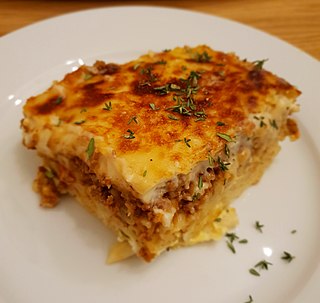
Pastitsio is a Greek baked pasta dish with ground meat and béchamel sauce, with variations of the dish found in other countries of the Mediterranean Sea.

Pappardelle are large, very broad, flat pasta, similar to wide fettuccine, originating from the Tuscany region of Italy. The fresh types are two to three centimetres wide and may have fluted edges, while dried egg pappardelle have straight sides.

Bucatini, also known as perciatelli, is a thick spaghetti-like pasta with a hole running through the center. It is common throughout Lazio, particularly Rome.

A kalis is a type of Philippine sword. The kalis has a double-edged blade, which is commonly straight from the tip but wavy near the handle. Kalis exists in several variants, either with a fully straight or fully wavy blade. It is similar to the Javanese keris, but differs in that the kalis is a sword, not a dagger. It is much larger than the keris and has a straight or slightly curved hilt, making it a primarily heavy slashing weapon.

Farfalle are a type of pasta. The name is derived from the Italian word farfalle (butterflies). In the Italian region of Emilia-Romagna, farfalle are known as strichetti. A larger variation of farfalle is known as farfalloni, while the miniature version is called farfalline. Farfalle date back to the 16th century in the Lombardy and Emilia-Romagna regions of Italy.

Rigatoni are a type of pasta. They are larger than penne and ziti, and sometimes slightly curved, but not as curved as elbow macaroni. Rigatoni are characterized by ridges along their length, sometimes spiraling around the tube; unlike penne, the ends of rigatoni are cut perpendicular to the tube walls instead of diagonally.

Italian-American cuisine is a style of Italian cuisine adapted throughout the United States. Italian-American food has been shaped throughout history by various waves of immigrants and their descendants, called Italian Americans.

Radiatori are small, squat pasta shapes that are said to resemble radiators. Although it is rumored that they were created in the 1960s by an industrial designer, their invention was actually between the First and Second World War. They are often used in similar dishes as rotelle or fusilli, because their shape works well with thicker sauces. They are also used in casseroles, salads, and soups. The form is sometimes called "pagoda pasta".
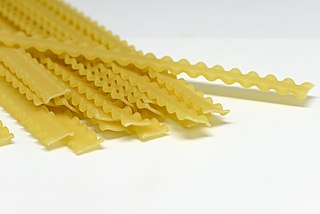
Mafaldine, also known as reginette or simply mafalda or mafalde, is a type of ribbon-shaped pasta.

Corzetti or croxetti are a type of pasta typical of the Ligurian cuisine of northeast Italy, and traditional also in the area of Novi Ligure just across the border with Piedmont, in the province of Alessandria. Corzetti originated in Liguria, in northern Italy along the border with France, during the Middle Ages. The name itself derives from a 14th century Genoan coin, the corzetto.
Lasagnotte is a type of flat and wide pasta. It is very similar to lasagnette and is used in dishes in the same manner as lasagnette; however, lasagnotte is longer in length and has a rippled edge on only one side.
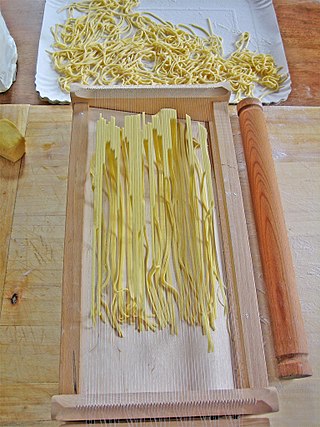
Spaghetti alla chitarra, also known as maccheroni alla chitarra, is a variety of egg pasta typical of the Abruzzo region of Italy, with a square cross section about 2–3 mm thick. Tonnarelli are a similar pasta from Lazio, used especially in the Roman cacio e pepe. Ciriole, traditionally from Molise, is the thicker version of chitarra, approximately twice the thickness of spaghetti. Because the pasta are cut from a sheet rather than extruded through a die, spaghetti alla chitarra are square rather than round in cross-section.

Vincisgrassi, also spelled vincesgrassi, is a typical Marche pasta dish similar to lasagna, considered one of the gastronomic emblems of the Marche cuisine.
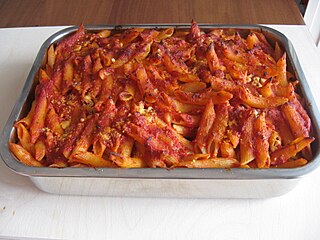
Pasta al forno or timballo di pasta is a typical dish of Italian cuisine, made of pasta covered with béchamel sauce, tomato sauce and cheese, and cooked in the oven.
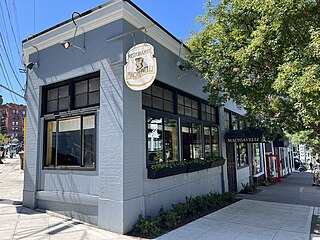
Ristorante Machiavelli is an Italian restaurant on Seattle's Capitol Hill, in the U.S. state of Washington. Housed in the historic Booker Building (1912), the business bills itself as "a Capitol Hill tradition since 1988" and offers a menu with pizzas, pastas, and other traditional cuisine which has changed little in three decades. Often regarded as one of Seattle's best Italian restaurants and one of Capitol Hill's best dining options, Ristorante Machiavelli has garnered a positive reception and has been recognized for its gnocchi, veal, and lasagna, in particular.

















